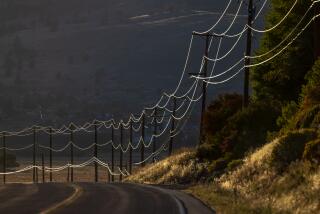Editorial: Millions of Californians are facing blackouts. But are we any safer from wildfires?

The intentional blackouts that have left millions of Californians without electricity this week have been branded “public safety power shut-offs” because they were intended to stop downed utility lines from sparking the kind of devastating wildfires that level communities and kill people. On the face of it, that sounds reasonable: After all, more than 2,000 fires — including the state’s deadliest and most destructive — have been sparked by electrical lines or equipment since 2014.
But the troubling fact is that despite the shut-offs, fires around California may still be igniting as a result of downed lines. At least four fires this month — including the Saddleridge fire and the still-raging Kincade fire in Sonoma County — may have been started by electrical equipment that was not shut off despite the dangerous weather conditions.
Pacific Gas & Electric reported malfunctioning high-voltage lines at the approximate time and place where the Kincade fire began. Curiously, although the low-voltage power lines serving homes and business were blacked out because of high winds, those high-voltage lines remained live. PG&E reported broken electrical equipment in two other incidents that preceded fires in Contra Costa county.
That was also the case in the Saddleridge fire earlier this month that burned at least 31 structures and contributed to the deaths of three people. The start of the blaze was preceded by witness reports of a fire under a high-voltage tower in Sylmar, and Southern California Edison reported a malfunction on those lines beforehand.
And on Tuesday, Mayor Eric Garcetti said the Getty fire was sparked by a tree branch that fell on power lines (although those lines are owned by the L.A. Department of Water and Power, which does not do systematic public safety power shut-offs).
So what’s going on here? At this point, Californians can legitimately wonder whether the blackouts are being employed in a sane or sensible manner. Are we experiencing fewer fires than we would without them — or are they ineffective because they’re badly thought out or poorly implemented?
We always knew that the preventive power shut-downs would come with certain costs. And when the final toll of October’s outages are tallied, the human, financial and environmental costs are likely to be staggering — thousands of refrigerators filled with spoiled food and medicine, lost paychecks from shuttered businesses, people hurt in accidents caused by the lack of traffic lights and untold amounts of greenhouse gases spewed into the atmosphere by diesel and gasoline power generators.
On top of that, there were serious problems with the implementation from the start. The websites of PG&E and Edison were unable to handle the volume of people trying to find out whether they’d be affected. State and local emergency providers weren’t given adequate notice of the shutdowns. There was little explanation why power was cut to some communities and not others. And thousands of people were never informed by PG&E that they might have their power turned off, including 500 customers who rely on power for medical reasons and are supposed to get extra notification and help. The outages have been so large in scope and so long in duration that they have raised the suspicions of many people, including Gov. Gavin Newsom, that the utilities are not using them, as planned, as a last resort.
If, in return for all that chaos and cost, the utilities were successfully preventing power lines from starting deadly fires, then it would be worth it. After all, San Diego Gas & Electric has used targeted blackouts during high-fire risk conditions successfully for a decade. But are we in fact safer?
We don’t know, and probably never will, if some fire was prevented this week because a particular power line was de-energized. But it would be great if the investigation of power shut-offs launched Monday by Newsom and the California Public Utilities Commission could offer some answers as well as better protocols and tighter rules for the next spate of blackouts. If Californians are going to have to endure a decade of planned power outages until the electrical grid is reformed and hardened enough to cope with the new realities of climate change, then we deserve as much reassurance as is reasonably possible that the dark days are making us all safer.
More to Read
A cure for the common opinion
Get thought-provoking perspectives with our weekly newsletter.
You may occasionally receive promotional content from the Los Angeles Times.






